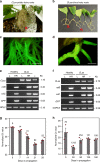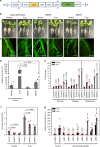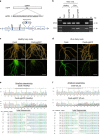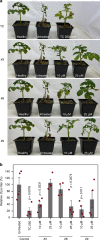Plant hairy roots enable high throughput identification of antimicrobials against Candidatus Liberibacter spp
- PMID: 33199718
- PMCID: PMC7669877
- DOI: 10.1038/s41467-020-19631-x
Plant hairy roots enable high throughput identification of antimicrobials against Candidatus Liberibacter spp
Abstract
A major bottleneck in identifying therapies to control citrus greening and other devastating plant diseases caused by fastidious pathogens is our inability to culture the pathogens in defined media or axenic cultures. As such, conventional approaches for antimicrobial evaluation (genetic or chemical) rely on time-consuming, low-throughput and inherently variable whole-plant assays. Here, we report that plant hairy roots support the growth of fastidious pathogens like Candidatus Liberibacter spp., the presumptive causal agents of citrus greening, potato zebra chip and tomato vein greening diseases. Importantly, we leverage the microbial hairy roots for rapid, reproducible efficacy screening of multiple therapies. We identify six antimicrobial peptides, two plant immune regulators and eight chemicals which inhibit Candidatus Liberibacter spp. in plant tissues. The antimicrobials, either singly or in combination, can be used as near- and long-term therapies to control citrus greening, potato zebra chip and tomato vein greening diseases.
Conflict of interest statement
The Texas A&M University System has filed patent applications for the microbial hairy root system [15/353,645 and 16/54,178, status pending]. K.K.M., S.I., M.R., S.P., and P.N. are co-inventors on the related disclosures and patents. Southern Gardens Citrus (Clewiston, FL) has licensed rights in these patents and patent applications from The Texas A&M University System. A disclosure of invention for the compounds screened using this system and a U.S. provisional patent application (63031962) has been submitted. Southern Gardens Citrus also provided matching funds to the Foundation for Food and Agricultural Research New Innovator Award (2018-534,299) to K.K.M. Co-author M.S.I. (Director of Research and Business Development, Southern Gardens Citrus) contributed to the study design for screening antimicrobial peptides, data analysis, and preparation of the manuscript. The remaining authors declare no competing interests.
Figures





Similar articles
-
HPE1, an Effector from Zebra Chip Pathogen Interacts with Tomato Proteins and Perturbs Ubiquitinated Protein Accumulation.Int J Mol Sci. 2021 Aug 20;22(16):9003. doi: 10.3390/ijms22169003. Int J Mol Sci. 2021. PMID: 34445707 Free PMC article.
-
Inoculation of Tomato With Plant Growth Promoting Rhizobacteria Affects the Tomato-Potato Psyllid-Candidatus Liberibacter Solanacearum Interactions.J Econ Entomol. 2023 Apr 24;116(2):379-388. doi: 10.1093/jee/toad006. J Econ Entomol. 2023. PMID: 36723158
-
Liberibacter crescens Is a Cultured Surrogate for Functional Genomics of Uncultured Pathogenic 'Candidatus Liberibacter' spp. and Is Naturally Competent for Transformation.Phytopathology. 2019 Oct;109(10):1811-1819. doi: 10.1094/PHYTO-04-19-0129-R. Epub 2019 Aug 13. Phytopathology. 2019. PMID: 31090497
-
Challenges for Managing Candidatus Liberibacter spp. (Huanglongbing Disease Pathogen): Current Control Measures and Future Directions.Phytopathology. 2018 Apr;108(4):424-435. doi: 10.1094/PHYTO-07-17-0260-RVW. Epub 2018 Jan 24. Phytopathology. 2018. PMID: 28990481 Review.
-
Huanglongbing Control: Perhaps the End of the Beginning.Microb Ecol. 2018 Jul;76(1):192-204. doi: 10.1007/s00248-017-1123-7. Epub 2017 Dec 1. Microb Ecol. 2018. PMID: 29196843 Review.
Cited by
-
HPE1, an Effector from Zebra Chip Pathogen Interacts with Tomato Proteins and Perturbs Ubiquitinated Protein Accumulation.Int J Mol Sci. 2021 Aug 20;22(16):9003. doi: 10.3390/ijms22169003. Int J Mol Sci. 2021. PMID: 34445707 Free PMC article.
-
Highly efficient Agrobacterium rhizogenes-mediated hairy root transformation in citrus seeds and its application in gene functional analysis.Front Plant Sci. 2023 Oct 31;14:1293374. doi: 10.3389/fpls.2023.1293374. eCollection 2023. Front Plant Sci. 2023. PMID: 38023879 Free PMC article.
-
Application of AtMYB75 as a reporter gene in the study of symbiosis between tomato and Funneliformis mosseae.Mycorrhiza. 2023 Jun;33(3):181-185. doi: 10.1007/s00572-023-01110-y. Epub 2023 May 18. Mycorrhiza. 2023. PMID: 37198421
-
Expression characteristics of CsPG23 in citrus and analysis of its interacting protein.Plant Signal Behav. 2025 Dec;20(1):2508418. doi: 10.1080/15592324.2025.2508418. Epub 2025 May 22. Plant Signal Behav. 2025. PMID: 40403246 Free PMC article.
-
Recent progress in the understanding of Citrus Huanglongbing: from the perspective of pathogen and citrus host.Mol Breed. 2024 Nov 6;44(11):77. doi: 10.1007/s11032-024-01517-1. eCollection 2024 Nov. Mol Breed. 2024. PMID: 39525404
References
-
- Haapalainen M. Biology and epidemics of Candidatus Liberibacter species, psyllid-transmitted plant-pathogenic bacteria. Ann. Appl. Biol. 2014;165:172–198. doi: 10.1111/aab.12149. - DOI
-
- Munyaneza J. Zebra chip disease of potato: biology, epidemiology, and management. Am. Potato J. 2012;89:329–350. doi: 10.1007/s12230-012-9262-3. - DOI
-
- Greenway G. Economic impact of zebra chip control costs on grower returns in seven US states. Am. Potato J. 2014;91:714–719. doi: 10.1007/s12230-014-9404-x. - DOI
-
- CNAS. Economic impacts of zebra chip on the Texas potato industry. http://cnas.tamu.edu/zebra%20chip%20impacts%20final.pdf (Center for North American Studies, 2006).
-
- Bové JM. Huanglongbing: a destructive, newly-emerging, century-old disease of citrus. J. Plant Pathol. 2006;88:7–37.
Publication types
MeSH terms
Substances
LinkOut - more resources
Full Text Sources
Research Materials
Miscellaneous

